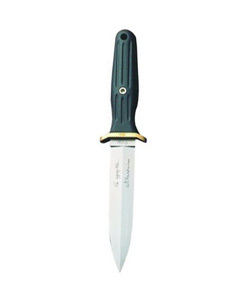|
Defendu
Close Quarters Combat System (also known as Defendu) is a modern martial art developed by William E. Fairbairn and Eric A. Sykes prior to World War II. It is a hand-to-hand combat system based on practical experience mixed with Jujutsu and boxing that was developed to train the Shanghai Municipal Police, and was later taught in expanded form to Office of Strategic Services and Special Operations Executive members during World War II. Development Based on his training and knowledge in boxing, wrestling, Savate, Jujutsu, Judo and street fighting he was involved in during his police work, Fairbairn began to develop his own system of hand to hand combat, initially referring to it as "Defendu". It was designed to be simple to learn and to provide effective results. Fairbairn published his book, ''Defendu'', in 1926 (re-printed as ''Scientific Self Defence'' in 1931), illustrating this method and it is here that the term "Defendu" first appeared. This confused early readers of the bo ... [...More Info...] [...Related Items...] OR: [Wikipedia] [Google] [Baidu] |
Martial Arts
Martial arts are codified systems and traditions of combat practiced for a number of reasons such as self-defense; military and law enforcement applications; combat sport, competition; physical, mental, and spiritual development; entertainment; and the preservation of a nation's intangible cultural heritage. Etymology According to Paul Bowman, the term ''martial arts'' was popularized by mainstream popular culture during the 1960s to 1970s, notably by Hong Kong martial arts films (most famously those of Bruce Lee) during the so-called "chopsocky" wave of the early 1970s. According to John Clements, the term '':wikt:martial art, martial arts'' itself is derived from an older Latin (language), Latin term meaning "arts of Mars (mythology), Mars", the Roman mythology, Roman god of war, and was used to refer to the combat systems of Europe (European martial arts) as early as the 1550s. The term martial science, or martial sciences, was commonly used to refer to the fighting arts of E ... [...More Info...] [...Related Items...] OR: [Wikipedia] [Google] [Baidu] |
Rex Applegate
Rex Applegate (June 21, 1914 – July 14, 1998) was an American military officer who worked for the Office of Strategic Services, where he trained Allied special forces personnel in close-quarters combat during World War II. He held the rank of colonel. Early life Applegate was born on June 21, 1914, in Oregon. He was a descendant of Charles Applegate, who blazed the Oregon Trail in 1843 with his brothers Jesse and Lindsay and established the Applegate Trail. Applegate began hunting and shooting at a young age and learned marksmanship from his uncle Gus Peret who was a famed exhibition shooter and professional hunter at the time. Applegate graduated from the University of Oregon with a Business Degree in 1940 and went on to take a commission in the US Army as a second lieutenant. His first billet was with the 209th Military Police Company as a lung ailment kept him from holding a combat position. World War II In 1941, Applegate was developing armed and unarmed close quarter c ... [...More Info...] [...Related Items...] OR: [Wikipedia] [Google] [Baidu] |
Hybrid Martial Arts
Hybrid martial arts, also known as hybrid fighting systems or sometimes eclectic martial arts or freestyle martial arts, refer to mixed martial arts or fighting systems that incorporate techniques and theories from several particular martial arts (eclecticism). While numerous martial arts borrow or adapt from other arts and to some extent could be considered hybrids, a ''hybrid martial art'' emphasizes its disparate origins. History The idea of hybridization or "mixing" of martial arts traditions originates in the 5th Century BC. The concept rose to wide popularity during 5th Century BC in Greek Olympic game Pankration, which uses aspects derived from various arts including boxing and wrestling. Examples of hybrid martial arts * Aikido S.A. (Japan) * American Kenpo (USA) *American Tang Soo Do (USA) *ARB (martial art) (Soviet Union/Russia) * Army Combatives (USA) * Bartitsu (United Kingdom) *Buttstroke *Close combat (Worldwide) *Combat Hapkido (USA) *Combat Hopak (Ukraine) * D ... [...More Info...] [...Related Items...] OR: [Wikipedia] [Google] [Baidu] |
Hand-to-hand Combat
Hand-to-hand combat (sometimes abbreviated as HTH or H2H) is a physical confrontation between two or more persons at short range (grappling distance or within the physical reach of a handheld weapon) that does not involve the use of weapons.Hunsicker, A., ''Advanced Skills in Executive Protection'', Boca Raton FL: Universal Publishers, , , p. 51 The phrase "hand-to-hand" sometimes include use of melee weapons such as knives, swords, clubs, spears, axes, or improvised weapons such as entrenching tools. While the term "hand-to-hand combat" originally referred principally to engagements by combatants on the battlefield, it can also refer to any personal physical engagement by two or more people, including law enforcement officers, civilians, and criminals. Combat within close quarters, to a range just beyond grappling distance, is commonly termed close combat or close-quarters combat. It may include lethal and non-lethal weapons and methods depending upon the restrictions impos ... [...More Info...] [...Related Items...] OR: [Wikipedia] [Google] [Baidu] |
Hand To Hand Combat
Hand-to-hand combat (sometimes abbreviated as HTH or H2H) is a physical confrontation between two or more persons at short range (grappling distance or within the physical reach of a handheld weapon) that does not involve the use of weapons.Hunsicker, A., ''Advanced Skills in Executive Protection'', Boca Raton FL: Universal Publishers, , , p. 51 The phrase "hand-to-hand" sometimes include use of melee weapons such as knives, swords, clubs, spears, axes, or improvised weapons such as entrenching tools. While the term "hand-to-hand combat" originally referred principally to engagements by combatants on the battlefield, it can also refer to any personal physical engagement by two or more people, including law enforcement officers, civilians, and criminals. Combat within close quarters, to a range just beyond grappling distance, is commonly termed close combat or close-quarters combat. It may include lethal and non-lethal weapons and methods depending upon the restrictions impos ... [...More Info...] [...Related Items...] OR: [Wikipedia] [Google] [Baidu] |
Self-defense
Self-defense (self-defence primarily in Commonwealth English) is a countermeasure that involves defending the health and well-being of oneself from harm. The use of the right of self-defense as a legal justification for the use of force in times of danger is available in many jurisdictions. Physical Physical self-defense is the use of physical force to counter an immediate threat of violence. Such force can be either armed or unarmed. In either case, the chances of success depend on various parameters, related to the severity of the threat on one hand, but also on the mental and physical preparedness of the defender. Unarmed Many styles of martial arts are practiced for self-defense or include self-defense techniques. Some styles train primarily for self-defense, while other combat sports can be effectively applied for self-defense. Some martial arts train how to escape from a knife or gun situation or how to break away from a punch, while others train how to attack. To ... [...More Info...] [...Related Items...] OR: [Wikipedia] [Google] [Baidu] |
Allies Of World War II
The Allies, formally referred to as the United Nations from 1942, were an international military coalition formed during the Second World War (1939–1945) to oppose the Axis powers, led by Nazi Germany, Imperial Japan, and Fascist Italy. Its principal members by 1941 were the United Kingdom, United States, Soviet Union, and China. Membership in the Allies varied during the course of the war. When the conflict broke out on 1 September 1939, the Allied coalition consisted of the United Kingdom, France, and Poland, as well as their respective dependencies, such as British India. They were soon joined by the independent dominions of the British Commonwealth: Canada, Australia, New Zealand and South Africa. Consequently, the initial alliance resembled that of the First World War. As Axis forces began invading northern Europe and the Balkans, the Allies added the Netherlands, Belgium, Norway, Greece, and Yugoslavia. The Soviet Union, which initially had a nonaggression pa ... [...More Info...] [...Related Items...] OR: [Wikipedia] [Google] [Baidu] |
Riot Control
Riot control measures are used by law enforcement, military, paramilitary or security forces to control, disperse, and arrest people who are involved in a riot, unlawful demonstration or unlawful protest. If a riot is spontaneous and irrational, actions which cause people to stop and think for a moment (e.g. loud noises or issuing instructions in a calm tone) can be enough to stop it. However, these methods usually fail when there is severe anger with a legitimate cause, or the riot was planned or organized. Riot control personnel have long used less lethal weapons such as batons and whips to disperse crowds and detain rioters. Since the 1980s, riot control officers have also used tear gas, pepper spray, rubber bullets, stun grenades, and electric tasers. In some cases, riot squads may also use Long Range Acoustic Devices, water cannons, armoured fighting vehicles, aerial surveillance, police dogs or mounted police on horses. Persons performing riot control typically wear p ... [...More Info...] [...Related Items...] OR: [Wikipedia] [Google] [Baidu] |
Physical Restraint
Physical restraint refers to means of purposely limiting or obstructing the freedom of a person's bodily movement. Basic methods Usually, binding objects such as handcuffs, legcuffs, ropes, chains, straps or straitjackets are used for this purpose. Alternatively different kinds of arm locks deriving from unarmed combat methods or martial arts are frequently used to restrain a person, which are predominantly used by trained police or correctional officers. This less commonly also extends to joint locks and pinning techniques. The freedom of movement in terms of locomotion is usually limited, by locking a person into an enclosed space, such as a prison cell and by chaining or binding someone to a heavy or immobile object. This effect can also be achieved by seizing and withholding specific items of clothing, that are normally used for protection against common adversities of the environment. Examples can be protective clothing against temperature, forcing the individual to re ... [...More Info...] [...Related Items...] OR: [Wikipedia] [Google] [Baidu] |
Office Of Strategic Services
The Office of Strategic Services (OSS) was the intelligence agency of the United States during World War II. The OSS was formed as an agency of the Joint Chiefs of Staff (JCS) to coordinate espionage activities behind enemy lines for all branches of the United States Armed Forces. Other OSS functions included the use of propaganda, subversion, and post-war planning. The OSS was dissolved a month after the end of the war. Intelligence tasks were shortly later resumed and carried over by its successors the Department of State's Bureau of Intelligence and Research (INR), and the independent Central Intelligence Agency (CIA). On December 14, 2016, the organization was collectively honored with a Congressional Gold Medal. Origin Prior to the formation of the OSS, the various departments of the executive branch, including the State, Treasury, Navy, and War Departments conducted American intelligence activities on an ''ad hoc'' basis, with no overall direction, coordination, or ... [...More Info...] [...Related Items...] OR: [Wikipedia] [Google] [Baidu] |
Special Forces
Special forces and special operations forces (SOF) are military units trained to conduct special operations. NATO has defined special operations as "military activities conducted by specially designated, organized, selected, trained and equipped forces using unconventional techniques and modes of employment". Special forces emerged in the early 20th century, with a significant growth in the field during the Second World War, when "every major army involved in the fighting" created formations devoted to special operations behind enemy lines. Depending on the country, special forces may perform functions including airborne operations, counter-insurgency, counter-terrorism, foreign internal defense, covert ops, direct action, hostage rescue, high-value targets/manhunt, intelligence operations, mobility operations, and unconventional warfare. In Russian-speaking countries, special forces of any country are typically called , an acronym for "special purpose". In the United State ... [...More Info...] [...Related Items...] OR: [Wikipedia] [Google] [Baidu] |
.jpg)







